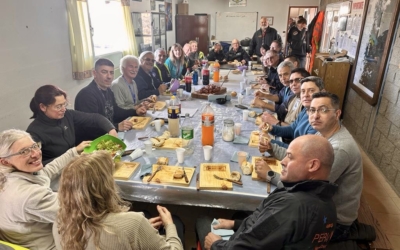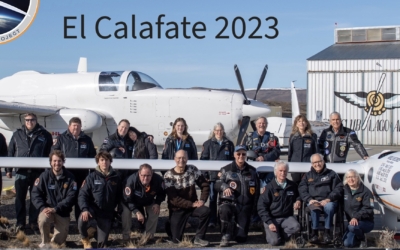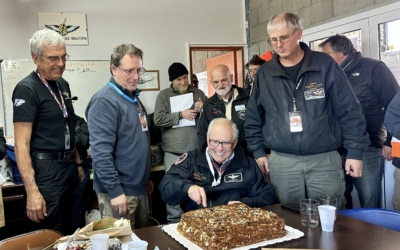The Airbus Perlan Mission II team has been keeping a low profile in Minden. We have quietly upgraded several systems in preparation for our return to high altitude wave attempts. On May 12 the team gathered for a final test flight of those systems. We waited for sprinkles and overcast sky to turn into foehn gaps and wave bars. The map shows wave bars right over Minden, which is exactly in the corner between Nevada and California. Here is the full story.
Chief Pilot and weather forecaster Jim Payne set the pace for the team. Morgan Sandercock would be copilot operating the new spherical 360 camera and the flutter vibration exciters. Doug Perrenod with Sandra Sandercock would be CapCom. Greg Scates was there to watch all his days of modifications and installations perform flawlessly. Stewart Tattersall led the ground crew for launch and recovery. Stewart’s built in windsock (beard) is priceless when hooking up the tow rope from a limited viz cabin. Really! And I tried to keep it all rolling along and take photos. Sort of a human checklist, so to speak.
They launched behind Silvio Ricardi in SoaringNV’s Pawnee. There was a stiff wind but Jim kept those 85 foot wings rock steady and level. The first huge test was in-flight pressurization. Andrew Oulett had worked on taking Jim’s idea for the hatches and building it, John Kregl had machined the parts and Greg Scates had installed the new latches. It had worked on the ground, would it now work while flying? And the answer was “Yes!” This allowed the cabin to stay cooler while at low altitudes and release any humidity. After getting established in wave they pressurized perfectly. Time to climb and test the other upgrades. Morgan really liked the new 360 degree spherical camera. There’s a round photo from the very top of the tail. Think of yourself as a bug sitting up there. The tail is close so it looks very large. The wings are way out front, so they look much shorter. But the gaps between the wave bar clouds show nicely. This video is visible in the cockpit real time – Morgan took a photo of the rear panel showing the camera display on the left. He also used another 360 degree camera to make a photo inside the rear cockpit.
Perlan Project has a letter of Agreement with Oakland Center Air Traffic Control. Perlan 2 was given permission to stairstep up to 31,000 feet. Then they had to hold, waiting for higher clearance. The wave was still working, so they performed several other flutter excitation tests as well as flying qualities manuevers. Since it was -40 degrees C outside all systems were cold soaked. Our upgraded heat tape with thermostats was very successful. The modifications on rebreathes that Tim Gardner figured out worked flawlessly.
Alas, after an hour of loitering in the cold, Oakland said they were unable to clear Perlan 2 to higher altitude. Their words were “equipment failure in the upper sector.” To be clear ATC had an equipment failure, not Perlan. There was enough lift at 30,000 feet to indicate that 40,000 feet was possible. Unfortunately when Jim called after landing there was no further explanation of that equipment failure. So the test points above 31,000 feet will be saved for Argentina. For records above 50,000 feet GPS altitude must be used. Most sailplane instruments calculate altitude based on air pressure. There are usually slight differences between pressure altitude and GPS altitude. The max altitude of this flight was 31,083 feet GPS and 30,492 feet pressure altitude.
The next test point was a rapid descent. With the air brakes fully extended the descent averaged 26 knots down. Flight time was 4.2 hours. The team was all smiles upon landing. We are ready for Argentina! Our Virtual Cockpit also got tested during this flight with some exciting new upgrades. Loris Gliner has added the ability to display tweets along side the instrument panel. We will be able to give almost real time information about what the viewer is seeing.
Thanks for taking the time to read and supporting Perlan Project.
Perlan soars! Jackie





